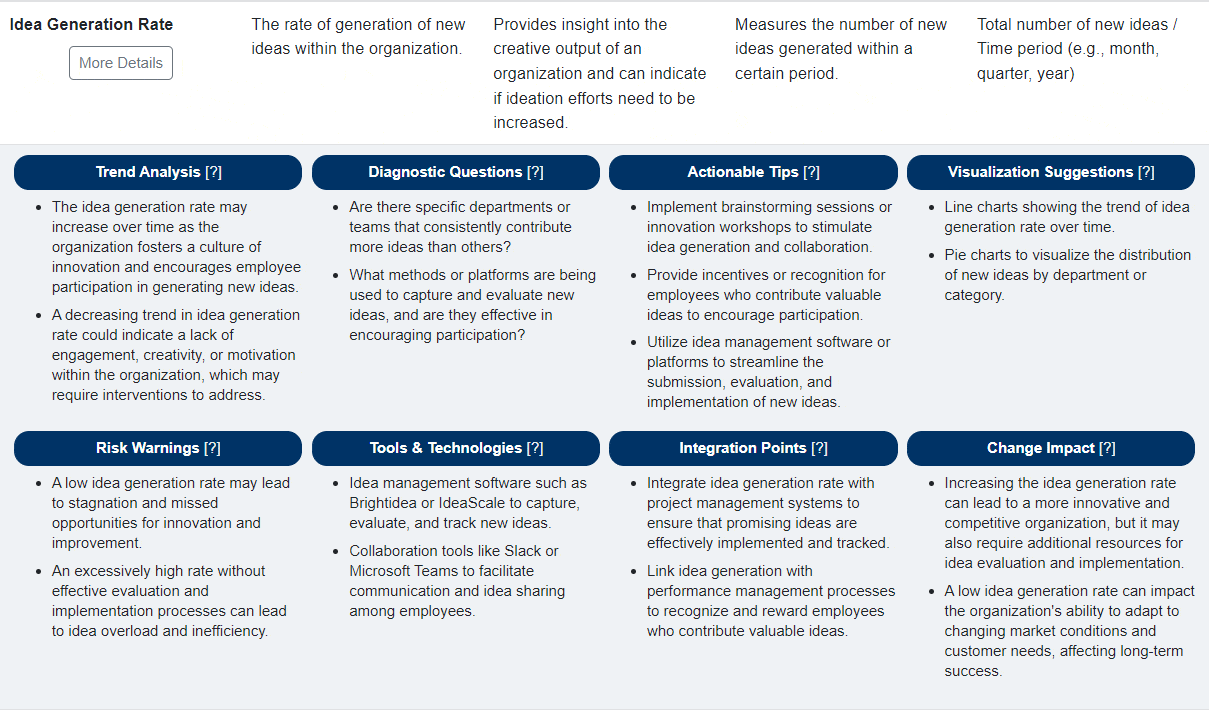Editor's Note: Take a look at our featured best practice, Cost Segregation Study: Multiple Property Class Analysis (Excel workbook). Accountants, accounting firms, and real estate property owners can all benefit from this cost segregation study (CSS) template. It makes the estimated benefit easy to figure out and has flexible assumptions for high level or detailed segregation analysis. You get a summary of cost [read more]
KPI Management: Innovation Pipeline Strength KPIs
* * * *

In the realm of strategic planning and performance measurement, understanding and optimizing the innovation pipeline is vital for aligning R&D activities with business objectives and market demands, ultimately driving sustainable success.
This article seeks to explore the significance of Innovation Pipeline Strength within organizations, highlighting how Key Performance Indicators (KPIs) associated with this area can aid in strategic decision-making, strategy formulation, and operational improvements. By examining these KPIs, we aim to provide insights that empower organizations to effectively manage their innovation processes, prioritize projects with the highest potential, and maintain a dynamic pipeline of new ideas that fuel growth and innovation.
Importance of the Strength of Your Innovation Pipeline
The Innovation Pipeline Strength is paramount for companies operating in rapidly evolving markets where technological advancements and customer preferences change swiftly.
A robust innovation pipeline not only secures a steady stream of new offerings but also enables organizations to respond proactively to emerging trends and disruptions. This strategic focus on nurturing and managing the innovation pipeline underpins an organization’s resilience, adaptability, and ability to explore new growth avenues.
Challenges to Consistent Innovation
Managing an effective innovation pipeline presents numerous challenges, including identifying and prioritizing high-potential projects, allocating resources efficiently, and ensuring a balanced portfolio of short-term wins and long-term bets. Organizations also struggle with maintaining momentum through the pipeline stages, from ideation to commercialization, and measuring the impact of innovation activities on overall business performance.
KPIs for measuring Innovation Pipeline Strength offer a way to navigate these complexities, providing clarity on the health and potential of the innovation pipeline, and guiding strategic decisions to optimize innovation outcomes.
Top 10 KPIs for Innovation Pipeline Strength
Optimizing the innovation pipeline requires a focus on KPIs that measure the effectiveness and efficiency of turning ideas into successful market offerings. Here are the top 10 KPIs essential for assessing Innovation Pipeline Strength. These KPIs are selected from the Flevy KPI Library, a robust database of over 15,000+ KPIs.
1. Idea Generation Rate
- Definition: The frequency at which new ideas are generated within the organization.
- Relevance: Indicates the organization’s capacity for continuous innovation and its ability to keep the pipeline filled with fresh ideas.
2. Pipeline Conversion Rate
- Definition: The percentage of ideas that move from one stage of the innovation pipeline to the next, ultimately leading to successful commercialization.
- Relevance: Measures the efficiency of the innovation process, highlighting potential bottlenecks or stages requiring optimization.
3. Idea to Launch Success Rate
- Definition: The proportion of generated ideas that are successfully developed and launched in the market.
- Relevance: A key indicator of the effectiveness of the organization’s innovation pipeline and its ability to bring viable products or services to market.
4. Innovation Cycle Time
- Definition: The time taken from idea generation to the commercial launch of a product or service.
- Relevance: Shorter innovation cycle times can provide a competitive advantage by ensuring quicker responses to market needs and trends.
5. Innovation ROI (Return on Innovation)
- Definition: The financial return generated from investments in innovation activities.
- Relevance: Critical for assessing the financial impact of the innovation pipeline on the organization’s overall performance and guiding future investment decisions.
6. Innovation Pipeline Value
- Definition: The estimated market value or potential revenue of projects currently in the innovation pipeline.
- Relevance: Provides insights into the future financial contribution of the innovation pipeline to the organization’s growth.
7. Cross-Functional Collaboration Index
- Definition: A measure of the effectiveness and frequency of collaboration between different functions or departments within the innovation process.
- Relevance: Enhances the quality and speed of innovation by leveraging diverse expertise and perspectives.
8. Customer Satisfaction with Innovations
- Definition: The level of customer satisfaction with new products or services developed by the organization.
- Relevance: Ensures that innovations meet customer needs and expectations, contributing to market success and customer loyalty.
9. Innovation Pipeline Flexibility
- Definition: The ability of the innovation pipeline to adapt to changes in strategic direction, market demands, or external challenges.
- Relevance: A flexible innovation pipeline allows organizations to pivot quickly in response to new opportunities or threats, maintaining relevance and competitiveness.
10. Stage Gate Pass Rate
- Definition: The percentage of projects that successfully meet criteria at each stage gate review and proceed to the next phase of development.
- Relevance: Indicates the quality and potential of innovation projects, ensuring that only the most viable projects advance through the pipeline.
To dig deeper into any of these KPIs, we invite you to explore the Flevy KPI Library, which allows you to drill down into 12 attributes for each KPI in the database. Here is an example for our top ranked KPI, Idea Generation Rate:
Innovation Pipeline Case Studies and Success Stories
Enhancing Market Responsiveness with Reduced Innovation Cycle Time
A consumer goods company recognized the need to reduce its “Innovation Cycle Time” to better respond to rapidly changing market trends and consumer preferences. Lengthy development processes had previously delayed product launches, resulting in missed opportunities.
The organization streamlined its innovation process by implementing agile development methodologies and enhancing “Cross-Functional Collaboration.” It focused on “Stage Gate Pass Rate” to ensure that only the most promising projects advanced, optimizing resource allocation.
Outcome: The strategic focus on reducing innovation cycle time led to a significant decrease in the time from idea to market, enabling the company to launch products more swiftly in response to emerging trends. This agility not only improved the “Customer Satisfaction with Innovations” but also positively impacted the “Innovation ROI,” demonstrating the financial benefits of a more responsive innovation process.
Lessons Learned: Streamlining the innovation cycle and fostering cross-functional collaboration are key to increasing market responsiveness. A disciplined approach to project advancement ensures resources are focused on the most viable innovations, enhancing overall pipeline value and customer satisfaction.
Maximizing Pipeline Value through Customer-Centric Innovations
A technology firm faced challenges in aligning its innovation efforts with market needs, reflected in lower-than-expected “Customer Satisfaction with Innovations” scores. The company sought to improve the relevance and impact of its innovation pipeline.
To better align its innovation activities with customer needs, the firm increased its focus on “Customer Involvement Index” and “Innovation Pipeline Flexibility.” It actively involved customers in the innovation process through feedback loops and market research, and it adopted a more flexible approach to project prioritization and development.
Outcome: By incorporating customer insights into the innovation process and enhancing pipeline flexibility, the company significantly improved the market alignment and value of its innovation projects. This led to higher customer satisfaction with new products and a notable increase in the “Innovation Pipeline Value,” reflecting the financial and strategic benefits of customer-centric innovation.
Lessons Learned: Engaging customers in the innovation process and maintaining flexibility in the innovation pipeline are critical for developing products that meet market needs and drive customer satisfaction. A customer-centric approach ensures that innovation efforts contribute meaningfully to both pipeline strength and overall business success.
Additional Resources and Further Reading
Foremost, if you are in the process of selecting or refreshing your Innovation Management KPIs, take a look at the Flevy KPI Library. With over 15,000+ KPIs, our KPI Library is one of the largest databases available. Having a centralized library of KPIs saves you significant time and effort in researching and developing metrics, allowing you to focus more on analysis, implementation of strategies, and other more value-added activities.
Here are other KPI Strategy and KPI Management articles we’ve published:
- Principles of KPI Selection. This article breaks down the 8 guiding principles to KPI selection and provides several case studies on how to use these principles in practice.
- Principles of KPI Maintenance. It’s important to recognize that as market conditions and strategic objectives evolve, so too must the KPIs. This article provides a disciplined approach to maintaining KPIs.
- KPI Dashboard Design & Visualization. Learn the art and science of designing KPI dashboards, including types of data visualization and how to choose among them.
- Anatomy of a Strong KPI. Learn what makes a KPI effective, discussing the characteristics of KPIs that are most impactful and how they can drive strategic business decisions.
- 10 Common Pitfalls in KPI Implementation. Learn how to identify and remediate the 10 most common pitfalls in KPI implementation. If left unfixed or as unknowns, these pitfalls can have disastrous, long-term impacts on the organization.
- KPIs and Organizational Alignment . This article discusses the concepts of strategic, tactical, and operational KPIs; as well as balancing individual, team, and organizational objectives.
- Integrating KPIs into Employee Performance. This article discusses 5 methods for integrating KPIs into individual performance metrics; and includes several case studies.
- Integrating KPIs into the Organizational Culture. This article breaks down 4 strategies for embedding KPIs into the Corporate Culture; also includes several case studies.
- Future-Proofing KPIs. Understand how to “future-proof” KPIs by understanding the impacts of emerging market trends, emerging technologies, and evolving consumer behaviors on KPIs.
- KPIs and Digital Transformation. All organizations are undergoing Digital Transformations. Learn how to define, select, and implement relevant Digital Transformation KPIs.

Do You Want to Implement Business Best Practices?
You can download in-depth presentations on 100s of management topics from the FlevyPro Library. FlevyPro is trusted and utilized by 1000s of management consultants and corporate executives.
For even more best practices available on Flevy, have a look at our top 100 lists:
- Top 100 in Strategy & Transformation
- Top 100 in Digital Transformation
- Top 100 in Operational Excellence
- Top 100 in Organization & Change
- Top 100 Management Consulting Frameworks
These best practices are of the same as those leveraged by top-tier management consulting firms, like McKinsey, BCG, Bain, and Accenture. Improve the growth and efficiency of your organization by utilizing these best practice frameworks, templates, and tools. Most were developed by seasoned executives and consultants with over 20+ years of experience.
Readers of This Article Are Interested in These Resources

|
|
145-slide PowerPoint presentation
|
|
Excel workbook
| |||
About Flevy Management Insights
Top 10 Recommended Documents














